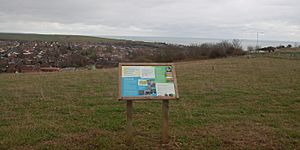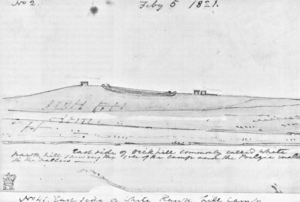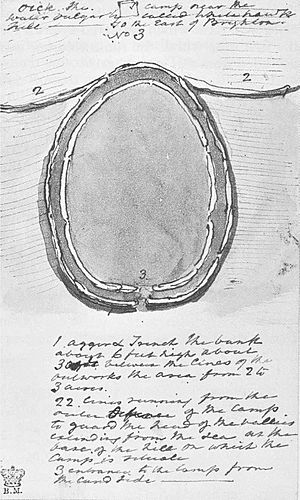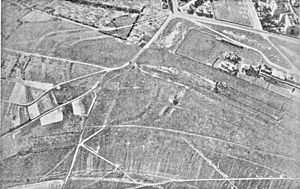Whitehawk Camp facts for kids
Quick facts for kids Whitehawk Camp |
|
|---|---|

Sign at Whitehawk Camp
|
|
| Type | Causewayed enclosure |
| Location | Near Brighton, East Sussex |
| Reference no. | 1010929 |
| Lua error in Module:Location_map at line 420: attempt to index field 'wikibase' (a nil value). | |
Whitehawk Camp is an ancient site near Brighton, England. It holds the remains of a causewayed enclosure. These are special earthworks built by people in the early Neolithic period. This was a time when people started farming, from about 4000 BC to 2500 BC.
Causewayed enclosures are areas surrounded by ditches. These ditches have gaps, like bridges, called causeways. We don't know exactly why they were built. They might have been places where people lived, met up, or held special ceremonies.
Whitehawk Camp has four main circular ditches. There are also earth banks inside some of these ditches. It's possible there was a wooden fence, called a palisade, on top of these banks. Some other ditches outside the main ones are from the Bronze Age. This was about 2,000 years after the first activities at the site.
Archaeologists first dug here in 1929. This was because football fields were planned for the area. More digs happened in the 1930s and 1990s when new building work was planned. Scientists used radiocarbon dating to figure out the age of the site. They believe the Neolithic part was built between 3650 and 3500 BC. It was probably used until about 3500 to 3400 BC. The site became a protected scheduled monument in 1923.
Contents
What Are Causewayed Enclosures?
Whitehawk Camp is a type of causewayed enclosure. These are ancient earthworks found in southern British Isles. They were built during the early Neolithic period, from around 3700 BC to 3300 BC.
These enclosures are areas partly or fully surrounded by ditches. The ditches have gaps or "causeways" of untouched ground. Sometimes, there were also earth banks or wooden fences.
Why Were They Built?
For a long time, experts have debated what these enclosures were for. Many ideas have been suggested.
- Settlements: Some thought people lived inside them. Early ideas even suggested people lived in the ditches!
- Meeting Places: They might have been seasonal gathering spots. People could have traded cattle or other goods like pottery.
- Ritual Sites: There's evidence that people left things like food, pottery, and even human remains in the ditches. This suggests they were used for special ceremonies or funeral rites.
- Defense: The causeways made them hard to explain as military forts. But some sites show signs of attacks. This supports the idea they might have been defended settlements.
Building these enclosures took a lot of effort. It needed many people working together. They had to clear land, prepare wood for fences, and dig huge ditches. This suggests good organization among the ancient communities.
Finding More Sites
In 1930, archaeologist E. Cecil Curwen found 16 possible Neolithic causewayed enclosures. Many more were discovered later, especially with the help of aerial photography in the 1960s and 1970s.
Most early sites were on high chalk hills. But new ones found from the air were often on lower ground. Today, over 70 are known in the British Isles. They are very common early Neolithic sites in western Europe. About a thousand are known across Europe. They appeared at different times, from before 4000 BC in France to around 3000 BC in Germany and Poland.
Digging Up the Past
The Whitehawk Camp site was first drawn by John Skinner in 1821. He was an amateur historian. Later, in 1908, Hadrian Allcroft wrote about the site in his book Earthworks of England.
The earliest maps from 1876 show only two of the ditches. Over time, parts of the site were built on, like the Brighton Racecourse and gardens. Eventually, the site became legally protected. But some building still happened without archaeologists checking it. For example, an earth bank was built to stop vehicles from entering.
Early Excavations (1929-1935)
Even though Whitehawk Camp was protected in 1923, this didn't stop all building plans. In 1928, there were plans to build football pitches on the site. The Brighton and Hove Archaeological Club protested. They decided to dig up part of the site. They wanted to find out its age and show how important it was to save.
Work started in January 1929. R.P. Ross Williamson and E. Cecil Curwen led the digs. They used a special tool called a boser to find the ditches underground. Their plan showed four circular ditches with many causeways.
They found many pieces of pottery, flint tools, and arrowheads. They also found nine pieces of human bone and many animal bones. These included pigs, cattle, and goats. They even found deer antlers. By studying snail shells, they learned that the climate in Neolithic times was probably wetter. Some seashells were also found, meaning people brought them from the coast.
Williamson noticed that Whitehawk Camp was very similar to other sites like Windmill Hill. He thought a large group of people lived there for a short time. He believed the ditches were used for rubbish, not for living in. Later studies suggested that the finds in the ditches had probably washed in from nearby areas.
More digs happened in 1932-1933 and 1935. This was because the Brighton Racecourse wanted to expand, and a new road was planned. During these digs, archaeologists found more interesting things:
- Roe Deer Skeleton: In one ditch, they found a hole with a complete roe deer skeleton. It might have been placed there as a special offering.
- Entrance: Post-holes in a ditch suggested an entrance to the enclosure, possibly with gateposts.
- Human Remains: Two almost complete adult skeletons were found. Other skull pieces showed at least five different people.
- Pottery: Most pottery was from the Neolithic period. Some Bronze Age pottery was found above these layers.
- Animal Bones: Many ox bones were found, often split to get out the marrow. Bones from sheep, goats, pigs, and dogs were also present.
- Tools: They found flint tools, including a leaf-shaped arrowhead, and a stone for grinding grain.
- Palisade: In 1935, post-holes suggested a wooden fence along the earth banks of the first and third ditches.
Later Discoveries (1991-2015)
In 1991, during new housing construction, another ditch was found. Miles Russell led this excavation. They found over a thousand worked flints and some pottery. Most pottery was from the Roman period, but two pieces were Neolithic. Russell thought this ditch might have been dug in the Neolithic period and then reused later.
Later studies of snail shells from this ditch suggested the area was open grassland when it was built. This meant it was likely built later than the main camp. Radiocarbon dating of bones from this ditch confirmed it was from the Bronze Age, much later than the main Neolithic camp.
Between 1991 and 2010, archaeologists kept an eye on building work around the site. They found some worked flints and sometimes uncovered the Neolithic ditches. Several surveys were also done to map the site.
In 2011, a big project called "Gathering Time" re-examined radiocarbon dates from many causewayed enclosures, including Whitehawk Camp. They concluded that all four main ditches at Whitehawk were built between 3650 BC and 3500 BC. The site was probably used for 75 to 260 years.
From 2014 to 2015, a "Community Archaeology Project" took place. Volunteers helped dig ten new trenches. They found some Neolithic flints. They also photographed and repacked old finds from the 1930s that weren't properly stored. A special survey found that modern rubbish in the ditches made them hard to detect, but they still showed up as "magnetic disturbances." The project also created an online game, Stone Age Quest, to teach kids about Whitehawk Camp.
Protecting Whitehawk Camp
Whitehawk Camp was the first site in Sussex to be listed as a scheduled monument in 1923. This helps protect it.
The camp has been featured in the local Brighton Museum & Art Gallery. In 2016, a film about the site was shown. In 2018, a reconstructed face of a woman whose remains were found in the 1930s was displayed. This was part of an exhibition about Brighton's past residents.
|




